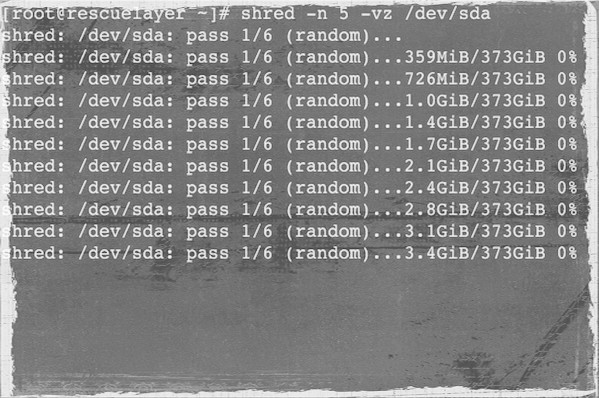The secure removal of data is not as easy as you may think. When you delete a file using the default commands of the operating system (for example “rm” in Linux/BSD/MacOS/UNIX or “del” in DOS or emptying the recycle bin in WINDOWS) the operating system does NOT delete the file, the contents of the file remains on your hard disk. The only way to make recovering of your sensitive data nearly impossible is to overwrite (“wipe” or “shred”) the data with several defined patterns. For erasing hard disk permanently, you can use the standard dd command. However, I recommend using shred command or wipe command.
Erase disk permanently under Linux
First, download a knoppix Live Linux CD or SystemRescueCd live CD.
Burn a live cd and boot your laptop or desktop from live CD.
How do I use the shred command?
Shred originally designed to delete file securely. It deletes a file securely, first overwriting it to hide its contents. However, the same command can be used to erase hard disk. For example, if your hard drive named as /dev/sda, then type the following command:
Sample outputs:
# shred -n 5 -vz /dev/sdaSample outputs:
Where,
- -n 5: Overwrite 5 times instead of the default (25 times).
- -v : Show progress.
- -z : Add a final overwrite with zeros to hide shredding.
The command is same for IDE hard disk hda (PC/Windows first hard disk connected to IDE) :
You can use wipe command to delete any file including disks:
# shred -n 5 -vz /dev/hdaYou can use wipe command to delete any file including disks:
# wipe -D /path/to/file.docSay hello to scrub
You can use disk scrubbing program such as scrub. It overwrites hard disks, files, and other devices with repeating patterns intended to make recovering data from these devices more difficult. Although physical destruction is unarguably the most reliable method of destroying sensitive data, it is inconvenient and costly. For certain classes of data, organizations may be willing to do the next best thing which is scribble on all the bytes until retrieval would require heroic efforts in a lab. The scrub implements several different algorithms. The syntax is:
To erase /dev/sda, enter:
# scrub -p nnsa|dod|bsi|old|fastold|gutmann|random|random2 fileNameHereTo erase /dev/sda, enter:
# scrub -p dod /dev/sda

No hay comentarios:
Publicar un comentario